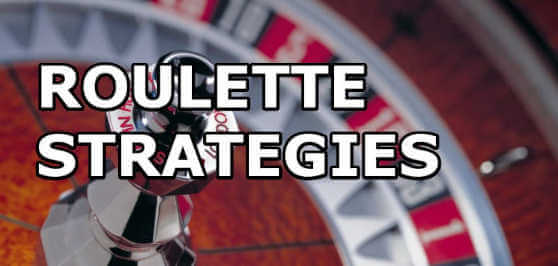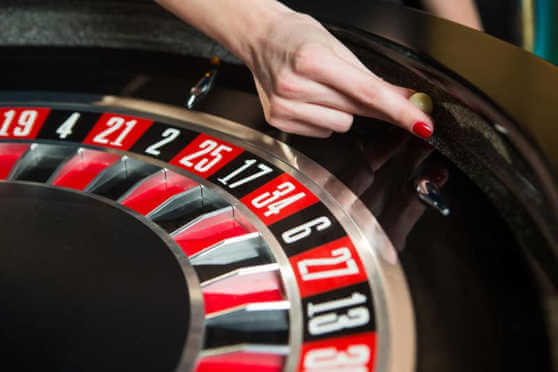
I’ve created this page to help you get maximum enjoyment when playing roulette, so you need to adopt a roulette strategy.
If you’re like me, you probably feel a bit intimidated by all of the possible betting options on the table. If that’s the case, you’ve either avoided playing or, when you’ve played, lost your bankroll in no time. Sound familiar?
If it does, read on as I’m going to cover several betting strategies that will help you play with confidence, manage your bankroll better, hopefully give you some wins, and, most importantly, allow you to enjoy your playing sessions.
If you’re on this page hoping for some magic roulette strategy to make you rich, I’m afraid it doesn’t exist, regardless of what you may have read and seen elsewhere.
![]()
Most well-known roulette strategies are played using the even bets (referred to as Outside Bets) on the table, and they all work on the same type of progression basis where you double or reduce your next bet depending on whether you win or lose on a spin.
None of the Strategies will make you rich, but if you get on a run, you can make some money as long as you bale out before the run ends.
Quite frankly, that is the most challenging thing to do. A canny player will know when and walk away with a profit. A player like me will push and push and generally walk away with nothing other than having had a good time.
Even money bets are Red / Black, Odd / Even, and High / Low numbers.
An automatic house edge is built into Roulette, which is controlled by the number of zeros included on the wheel. A single Zero, commonly referred to as European Roulette has a house edge of 2.7%. Double zero, also known as American Roulette, has a house edge of 5.26%.
It’s possible to minimise the house edge on European Roulette if you’re playing even money bets by finding a casino that offers La Partage. This will often be marked as French Roulette. The rule returns half your even-money stake if the ball lands at Zero.
Make sure you pick a Live Casino with a low minimum and high maximum stake range. As most strategies involve doubling your bet, you can quickly run out of betting options. Unibet and Leo Vegas have some of the best stake ranges and are casinos I trust.

The Martingale Strategy is probably one of the most well-known betting strategies that can be applied to almost any betting situation.
The premise is that you double your last losing bet until you win. That way, you recover all of your previous losses with one large bet and profit from the amount of your first stake in the progression.
Whilst the Martingale strategy can be used anywhere on the table, if you’re starting, I’d stick to one of the even-money bets such as Odds/Evens, Red/Black, or High/Low. It doesn’t matter if you follow the same pattern each time; it is important to double your next bet following a loss.
A typical sequence starting with £1 as your initial bet would be 1, 2, 4, 8, 16, 32, 64, 128, 256, 512, 1024, 2048, etc.
So if you had a sequence of 9 losing bets with the 10th one winning, you would need a bankroll of 1023, giving you a profit of 1. Was it worth it?
Pros – Easy to understand. One win returns all your previous losses.
Cons – Not very exciting, When you win, your profit is small; you need a large bankroll to ride through any losing streaks. Table limits may become an issue, so check before you start that you’ll be able to follow a sequence through.

The reverse Martingale Strategy works oppositely from the regular Martingale strategy.
You’re aiming to maximise your chances of winning by increasing your bets while on a winning run. So each successful gamble, you double your next bet.
This strategy is best played with one of the even-money bets, red/black, odds/evens. High/low. You aim to hit a sequence and follow it until you reach your pre-agreed bale-out moment.
So let’s say that you have decided that your bale-out moment will be a sequence of 4. You bet 1, then 2, then 4, then 8. You then bale out with a profit of 15. If you lose anywhere in the sequence, your maximum loss will only be 1.
Sounds alright, doesn’t it?. Well, it doesn’t show the number of losses you have had before you reach your bale out point. You may have had ten rounds of no wins or losing sequences, so 15 is now only worth a five profit.
Pros – A simple strategy to follow, the potential to win big if you hit a sequence early, but you must bale out to cash in.!
Cons – Table limits may affect where your bale out limit will be. You need a large bankroll if you select a long sequence for your bale-out point. You will likely have many losing sequences. Keep an eye on them as they soon mount up. A bit boring.

Labouchere is among the most complex systems out there. It is also known as Split Martingale, the Cancellation System and American Progression.
It involves increasing bets after losing.
Martingale attempts to recoup all losses in a single bet. Labouchere attempts to do so with multiple wins. Or, more precisely, the Labouchere system cleverly keeps track of your losses and then tries to shave off the losses one by one.
You start with a sequence of numbers. It can be any sequence, say, 1-2-3. Your bet will be the sum of the first and last number in your series, in this case, 4.
If you lose, four is added to the sequence, 1-2-3-4, so your next bet is 1+4=5. When you win, you cross the numbers, in this case, 1 and 4, so you’d be left with 2-3.
What’s cool about this system is that it will be profitable even if you win less than 50% of your bets, provided you avoid a lengthy losing streak.
The long losing streak will still be just as problematic as with Martingale, but if you avoid it, you’ll likely make money.
It might just be the best you can hope for in roulette.

In Reverse Labouchere, you add numbers to your sequence when you win and remove numbers when you lose.
Long winning streaks may result in huge gains; on the other hand, you can only lose the amount determined by your starting sequence.

The D’Alembert Strategy is very much a system suited to even money bets. This is a low-risk system; you won’t lose or win much or need a large bankroll to play.
The basic premise is that you reduce your bet by one when you win and increase your bet by 1 when you lose. Like the previous strategies, you need to set a bale limit to maximise your winnings or minimise your losses.
So as an example:
So in this six-bet sequence, you’ve ended up winning 3.
Pros – Small bankroll needed, low risk, small losses.
Cons – Small wins, only even money bets.

As it says, you do the reverse of the D’Alembert strategy. You increase your bet by one for every win, and for every loss, you reduce your bet by one.
So using the same sequence as above
In this 6-bet sequence, you end up with a loss of 3.
Pros – You need to set your bale out limit and stick to it.
Cons – You’ll only win if you have more wins than losses in a sequence.

The Fibonacci number scale was developed in 1202 and is a way of sequencing numbers. The numbers are sequenced by creating the next number from the sum of the previous two numbers. So starting from 1, you get 1, 1, 2, 3, 5, 8, 13, 21, 34, 55, 89………etc.
Roulette players have adopted the number sequence to bet on even money numbers, similar to the Martingale strategy. The Fibonacci system does not recover all losses from one single win but several smaller wins.
This is a lower-risk or low-variance strategy, whereas Martingale is a high-variance / higher-risk strategy.
The difference with this strategy is when you lose, you increase your stake to the next in the sequence. You take two steps back in the sequence when you win and place your next bet using that number.
I’ll use the same six-bet sequence used in the D’Alembert example to show you how it works.
If you win on any of the first three bets, you always restart from position 1.
In this instance, you have won 4 and lost 3, so you’re up by 1.
Working your way back to the beginning of the sequence will give you a profit of 1. A lot of work, you may think, and sometimes it can take ages for you to get there.
Pros – Small losses, Small wins, It’s less risky than the Martingale strategy, and you won’t be betting such large amounts on a single spin.
Cons – It’s a bit complicated. You have to keep track of what you’re doing, so a pen and paper are essential. Cancels out losses slowly. Unlikely to win a large sum. It can take a long time to get back to the beginning of the sequence.
You need more wins than losses to turn a profit, so keep in mind either the profit you want to reach or the number of wins in the sequence you’ll bale out from.

With the Fibonacci System, you move one step forward with a loss and two steps back with a win.
With the Reverse Fibonacci System, you do the opposite.
When you win you move a step forward and when you lose you move back two steps.
So the sequence is 1, 1, 2, 3, 5, 8, 13, 21, 34, 55, 89………etc.
So you have 3 wins and 3 losses and end up -1 down.
Unlike the Fibonacci System where you’d turn a profit of 1 in the reverse, you end up 1 down.
Now, this strategy works best when you have runs going and you are increasing your bet after each win.
The key is to bale out before you get the loss, so set yourself a limit and stick to it.
This is riskier than the normal Fibonacci system so I’d not recommend playing it.

Paroli system is similar to Reverse Martingale but comes with its own unique set of rules. When you win three bets in a row – the chance for that is 12.50% on even-money bets – the sequence is complete, and you start over.
Say your starting bet is £100. If you won three times in a row on Red/Black, you would have won £200 on a £100 bet, then £400 on a £200 bet, and finally £800 on a £400 bet. In essence, you won £800 on a £100 bet – and have placed that £100 bet on a chance that you’ll win three times in a row.
This is no different than putting three sports bets on a single ticket so the odds multiply and you win more. Mathematically, there’s nothing to be gained. This system is reliant on luck regarding winning streaks. If your wins do happen to often come in chunks of three, you’ll walk away a rich man.
Reverse Martingale and Paroli progressive betting systems make a certain sense as they try to exploit the wild unpredictability of roulette to your benefit. In contrast, Martingale attempts to tame it to prevent losses.

Oscar’s Grind is an attempt to win a measly 1 unit in each betting sequence. After that, the series starts again.
When you keep losing, you keep betting the exact amount and only increase it if you win following a loss.
That’s when you increase the bet by 1. That means that you start reinvesting your won money.
Just like Martingale and Labouchere, if you have an infinite bankroll, you will always make a profit with Oscar’s Grind.
The idea here is that you can get compensated for a 5-long losing streak with a 3-long winning streak.
In practice, this strategy works quite often. If you avoid a long losing streak and are disciplined enough, you will eventually come out on top by 1 unit.
Remember these are playing strategies, not winning strategies.
At some point during the sequence, you will be up more than 1 point so you have to decide whether it is more important for you to stop and bank your profit or continue and chance to make a loss.
Remember having a good time should be your priority when playing roulette so you should play at some of the best live roulette casinos I‘ve listed on this site.
In theory and practice, all progressive betting roulette systems rely on the misconception known as the gambler’s fallacy, which is a false belief that some outcome is due.
In other words, every one of the systems listed above is hoping that the losing streak won’t be too long, as that’s deemed less probable than a short losing streak.
This is not the case.
Every roulette spin is independent of all previous and future spins, and the chance is always the same.
Any sequence of Red and Black over, say, 20 spins are equally probable – a perfect string of Red, Black, Red, Black, all 20 Reds or all 20 Blacks.
Players who play progressive betting systems will eventually encounter a long losing streak and lose all their money.
That’s why it’s essential to have a safeguard or limit on how much money you’re prepared to lose. If and when you lose that amount, the sensible solution is to stop.
Chasing losses with progressive betting systems such as Martingale is a very, very bad thing to do.
I believe the most accurate sentence about progressive betting systems is that they work sometimes but will eventually lose you all your money at least once.
In other words, you may see moderate success with any of the systems listed above. However, with all of them, when you encounter a long losing streak, you will lose.
Even if the system somehow safeguards you from massive losses, it is almost inevitable that you will be chasing losses yourself by starting a new sequence (or trying out a new system), as the progressive betting systems taught you to do.
Eventually, the game of roulette and the progressive betting systems are a terrible combination that will find a way to lose your entire bankroll.
Be sensible about the whole thing.
Don’t think the roulette game owes you anything; don’t think a betting system can tame it.
Then you might have fun and win some money.
Remember having a good time should be your priority when playing roulette. Play at some of the best live roulette casinos on this site.